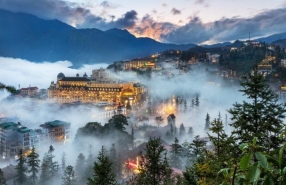Top 17 Best Things To Do In Hoi An, Vietnam

Hoi An is a small city in Quang Nam province, Vietnam. In 1999, Hoi An ancient town was officially recognized by UNESCO as a World Cultural Heritage Site. With picturesque charm and long-standing cultural heritage, Hoi An attracts tourists from all over the world. Coming to Hoi An, what should tourists do and what places should they go to so as not to miss the ancient beauty associated with long-standing cultural values? Autour Asia will suggest the top 17 must-do in Hoi An Vietnam in the article below. With its timeless beauty and friendly atmosphere, Hoi An is a must-visit for travelers looking for an authentic Vietnamese experience.
What to do in Hoi An Vietnam?
- 1. Walk around Hoi An ancient town
- 2. Visit the Japanese covered bridge (Chua Cau Hoi An)
- 3. Admire the Tan Ky ancient house
- 4. Explore the Phung Hung ancient house
- 5. Visit Fujian assembly hall (Hoi quan Phuc Kien)
- 6. Have fun at Bay Mau coconut forest
- 7. Explore Tra Que vegetable village
- 8. Discover Kim Bong carpentry village
- 9. Visit Thanh Ha pottery village
- 10. Visit Ha Linh Lantern Manufacturing Unit
- 11. Visit Hoi An handicraft workshop
- 12. Attend a show at Hoi An memories land
- 13. Relax at An Bang beach
- 14. Discover My Son sanctuary
- 15. Take a day trip to Cham island (Cu Lao Cham)
- 16. Shop at Hoi An central market
- 17. Visit the Museum of Folklore in Hoi An
1. Walk around Hoi An ancient town
- Address: Cẩm Châu, Hội An city, Quảng Nam province, Việt Nam
- Entrance fee: 120,000 VND/ pax (5 USD)
- Opening hours: 07:30 am - 9:30 pm
- Google Map: https://goo.gl/maps/xMFB2aF2B1cg3KJF9

If you only have one day in Hoi An but don't know where to go to make the most of that short time, walking around the old town will be a great idea. Hoi An ancient town is only about 30 km southwest of Da Nang city center. With its 400-year-old history and stunning architectural beauty, Hoi An offers a glimpse into the past, where tiled-roof houses and vibrant lantern-lit streets create a picturesque scene. Despite going through the ups and downs of history, the ancient town of Hoi An exudes a tranquil allure that beckons visitors to return.
A feature of Hoi An's architecture is the streets built in the shape of a chessboard, winding along the riverside and embracing houses. As you wander through the streets, visitors can easily encounter street vendors with famous cuisines in every corner. This will be an opportunity for you to savor the cuisine and learn about the locals' pace of life.
2. Visit the Japanese covered bridge (Chua Cau Hoi An)
- Address: 186 Trần Phú street, Minh An ward, Hội An city, Quảng Nam province, Việt Nam
- Opening hours: 09:00 am - 10:00 pm
- Google Map: https://goo.gl/maps/PiXjNL7PMU689QJe8
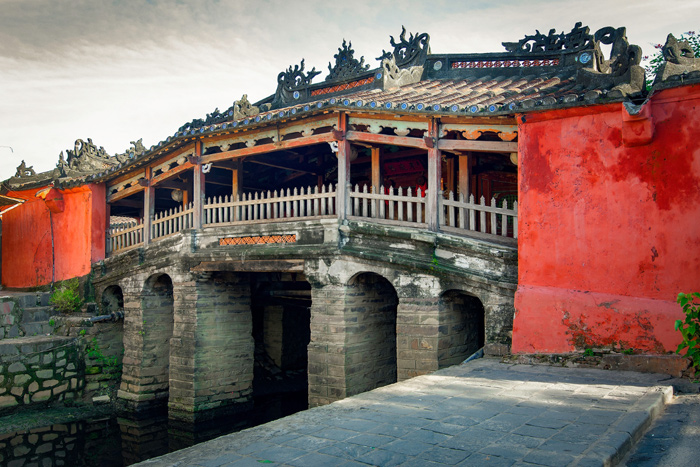
The Japanese covered bridge is also known as the Japanese Bridge or Lai Vien Kieu. The Japanese covered bridge was built in the 17th century by Japanese traders. With 400 years of history, this work has become a tourist symbol of Hoi An and plays an important role in the spiritual life of the region, where Vietnamese, Chinese, and Japanese cultures intersect harmoniously.
According to Japanese legend, the Bridge Pagoda is believed to be a sword that pierced the back of the monster Namazu, preventing it from wagging its tail and causing earthquakes. As a result, the country remains peaceful and prosperous. In 1719, Lord Nguyen Phuc Chu named the bridge "Lai Vien Kieu," which means "a bridge welcomes guests from afar." In 1990, the Japanese covered bridge was recognized as a National Historical - Cultural Relic. Currently, the image of the bridge is also displayed on the back of the 20,000 VND polymer banknote, issued in 2006. Therefore, this bridge has great historical and cultural value.
Unlike traditional temples, the Hoi An Bridge Pagoda does not worship Buddha but reveres the guardian deity of the nation who brings joy and happiness to people. As a result, it has become a destination that both locals and tourists constantly visit with the desire to find good things - must-do in Hoi An Vietnam.
3. Admire the Tan Ky ancient house
- Address: 101 Nguyễn Thái Học street, Minh An ward, Hội An city, Quảng Nam province, Việt Nam
- Opening hours: 08:30 am - 05:45 pm
- Google Map: https://goo.gl/maps/GPfpW953VFvxKS256
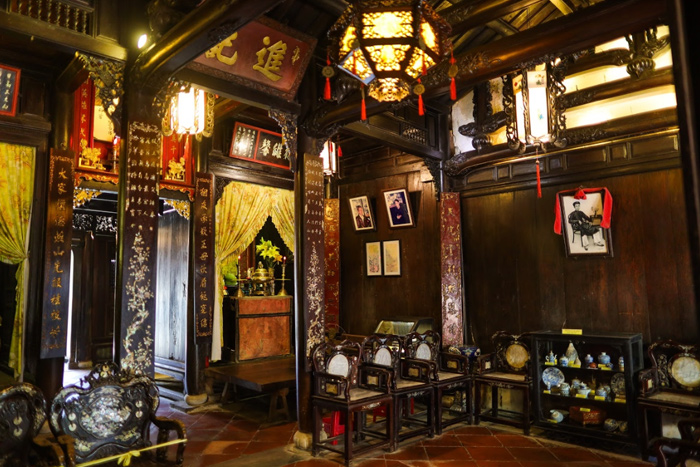
Tan Ky ancient house is the first old house to be honored as a national heritage and still retains almost intact the typical architecture of Hoi An. With a history spanning more than two centuries, this house stands as a living testament to the rich cultural and commercial exchanges.
Seven generations of the Le family have lived in this old house since it was constructed in 1741. Tan Ky ancient house consists of 2 floors and 3 compartments, built in the architectural style of interference between 3 cultures: Vietnam, Japan and China. The house is built with the main material is precious wood, the details are intricately and elaborately carved.
Today, the owner of the house is still living in the upper floor area, and the ground floor area will be for visitors to visit. Visitors here will get a glimpse of Hoi An's life and prosperous trading period. Each room of the house reflects different periods and lifestyles, adorned with calligraphy and ancient maps that echo the history of the house.
Visiting Tan Ky Ancient House - must do in Hoi An is more than simply admiring the architecture; it is a journey to the soul of Hoi An, a journey that reveals the profound connection between cultures and the enduring legacy of art, trade, and heritage in this charming city.
4. Explore the Phung Hung ancient house
- Address: 4 Nguyễn Thị Minh Khai street, Minh An ward, Hội An city, Quảng Nam province, Việt Nam
- Opening hours: 08:00 am - 06:00 pm
- Google Map: https://goo.gl/maps/QRLbZ1e9XDZgbo7H8
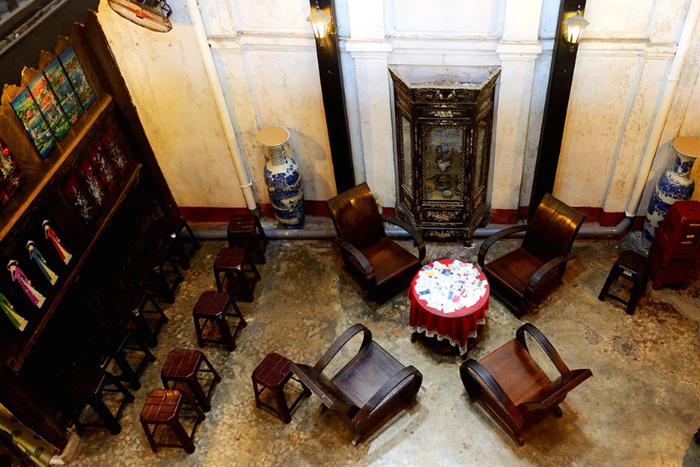
What to do in Hoi An? Phung Hung Ancient House is not only a unique tourist destination but also a testament to the rich heritage and splendid architecture of Hoi An, Vietnam. Phung Hung ancient house was built by a Vietnamese merchant in the late 18th century, during the flourishing period of the port town of Hoi An. He named the house Phung Hung with the wish that the family would have a prosperous business. In the past, this was a shop selling forest products such as cinnamon, pepper, salt and silk, porcelain, glass... This old house has been passed down through generations, the current owner now is the 8th generation descendant, living and preserving the old house.
The architecture of the house is influenced by 3 cultures of Japan, China and Vietnam. With a picturesque façade decorated with elaborate carvings and traditional symbols, Phung Hung Ancient House is an ideal place to explore. Inside the house there is a quiet courtyard, separate from the hustle and bustle of the busy street outside.
Phung Hung ancient house was recognized as a National Historical - Cultural Relic on June 29, 1993. Up to now, the house still retains almost intact architectural lines, interior and exterior. It is open to the public, allowing visitors to admire the beauty of architecture, cultural interference and explore the life of the ancient Hoi An merchant class.
5. Visit Fujian assembly hall (Hoi quan Phuc Kien)
- Address: 46 Trần Phú street, Cẩm Châu ward, Hội An city, Quảng Nam province, Việt Nam
- Opening hours: 07:00 am - 05:00 pm
- Google Map: https://goo.gl/maps/krkezny8HVKnY1Gg8

The Fujian Assembly Hall, also known as the Phuc Kien Assembly Hall, is one of the favorite destinations of tourists when coming to Hoi An. This is a testament to the vibrant cultural exchange between the Chinese Fujian community and the local Vietnamese.
Dating back to the 17th century, the Fujian Assembly Hall was initially built by the Phuoc Kien people who have lived in Hoi An for a long time. This assembly hall is like a place to gather, worship the gods, and conduct business in the Fujian community.
Phuc Kien Assembly Hall is the place to worship the goddess Thien Hau, the Bodhisattva Avalokitesvara and the guardians of sailors and fishermen. The Fujian Assembly Hall, with its religious significance, became a place of worship and prayer for the safety and success of seafarers in their journey.
Beyond its religious significance, the Fujian Assembly Hall serves as an important economic and social center for the Chinese community. This place contributes to promoting business relationships between Fujian traders and Vietnamese traders. The hall also played a vital role in resolving disputes and maintaining communal harmony among the Chinese residents.
When visiting the Assembly Hall of Fujian, visitors should wear polite and discreet clothes to show respect for historical and cultural relics. Come here and take beautiful pictures with family and friends!
6. Have fun at Bay Mau coconut forest
- Address: Cẩm Thanh ward, Hội An city, Quảng Nam province, Việt Nam
- Opening hours: 07:00 am - 05:00 pm
- Entrance fee: 30.000 VND/ pax (2 USD)
- Ticket for a basket boat: 150,000 VND - 200,000 VND/ boat ( maximum 2 pax/ boat) ( 7 USD - 9 USD)
- Google Map: https://goo.gl/maps/xDPYz6zimMsNFmGY8
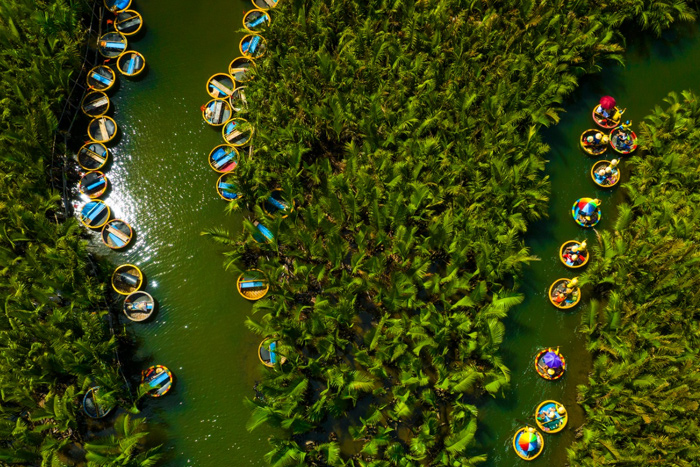
Bay Mau coconut forest is one of the famous eco-tourism in Hoi An, one of the best things to do in Hoi An, attracting many tourists. Situated just 3 km away from the old town, this tourist spot offers a lot of interesting activities and folk games such as: sailing basket boat, watching basket dance and boat racing, making souvenirs from pandan leaves, fishing, enjoying the local food,...
Riding a basket boat is a favorite activity of tourists. Visitors will see the artisans rowing boats and experience the freshness in the journey to explore the coconut forest
Bay Mau coconut forest promises to give you an unforgettable journey and an authentic experience.
7. Explore Tra Que vegetable village
- Address: Cẩm Hà ward, Hội An city, Quảng Nam province, Việt Nam
- Opening hours: 08:00 am - 05:00 pm
- Tel: +84 982 814 063
- Entrance fee: 35.000 VND/ pax (2 USD)
- Google Map: https://goo.gl/maps/scfx8cDjndxkFtCEA

Tra Que Vegetable Village is recognized as a national intangible cultural heritage in 2022. This is one of the very few vegetable villages that still applies the old organic vegetable growing method. Exploring Tra Que vegetable village will be an opportunity for you to become a hardworking farmer. You will be guided and taught how to tilling the soil, sowing seeds, nurturing plants, and harvesting the freshest vegetables by friendly locals. This activity is a bit hard but brings a lot of fun and helps visitors understand more about life and people in Tra Que vegetable village. In addition, visitors can also participate in cooking classes and use the vegetables to make ingredients for their dishes.
Whether you're a nature lover, a culinary enthusiast or looking for a serene escape, Tra Que Vegetable Village ( must-do in Hoi An Vietnam) promises an unforgettable and enriching vacation for all.
8. Discover Kim Bong carpentry village
- Address: Cẩm Kim ward, Hội An city, Quảng Nam province, Việt Nam
- Entrance fee: 35.000 VND/ pax (2 USD)
- Google Map: https://goo.gl/maps/Y6cXRCgtd5NGQYSW9
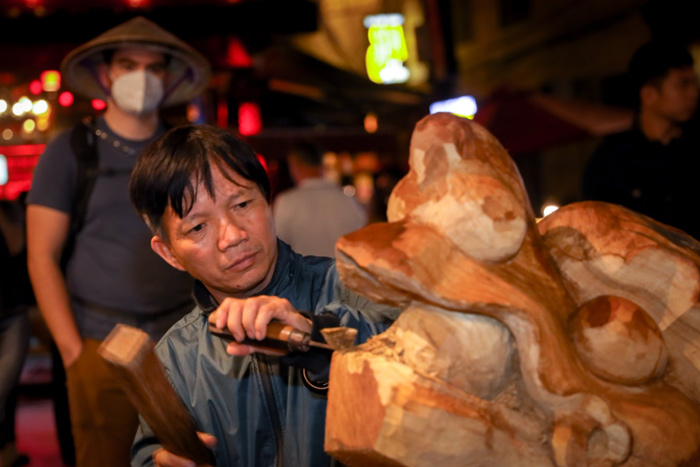
Welcome to Kim Bong Carpentry Village, a place where craftsmanship and tradition converge in the heart of Hoi An Vietnam. This village has a rich history dating back centuries and is renowned for its skilled artisans who have passed down their carpentry techniques from generation to generation. As you wander through the village, you'll witness the magic of woodworking firsthand, observing the process of making wood products. Additionally, visitors can also experience the process of knitting bamboo and making mats. All these activities are meaningful and indispensable in the life of Hoi An people. Coming to this traditional village, do not forget to buy wooden souvenirs for your loved ones. Kim Bong Carpentry Village is a testament to the enduring spirit of Vietnamese craftsmanship and is a must-visit destination for anyone.
9. Visit Thanh Ha pottery village
- Address: Thanh Hà, Hội An city, Quảng Nam province, Việt Nam
- Entrance fee: 35,000 VND/ adult (2 USD) and 15,000 VND/ child (1 USD)
- Google Map: https://goo.gl/maps/NPEeBtfGJXD3b7448
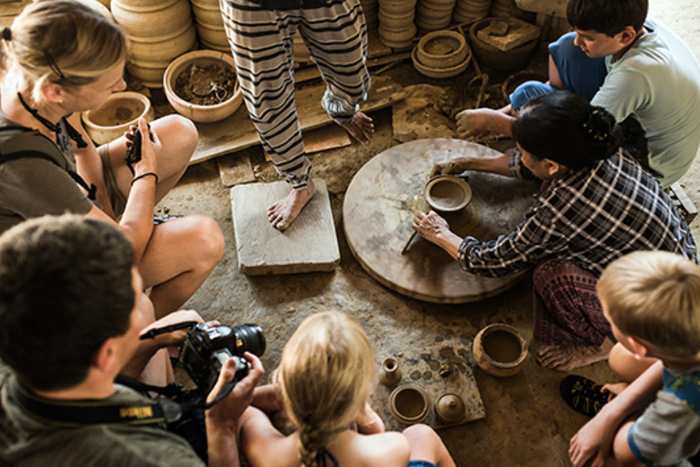
Thanh Ha Pottery Village is a charming and historic village located just a few kilometers from Hoi An's ancient town in Vietnam. Renowned for its traditional pottery craftsmanship, Thanh Ha has been producing fine pottery for more than 500 years. When visiting the village, tourists can witness skilled artisans at work, shaping clay into various beautiful and functional pieces using traditional techniques passed down through generations. Visitors can also experience creating their own pottery and take it home as souvenirs. Through the guidance of the artist, you can shape common items or anything you like. This will be one of the traditional craft villages worth visiting for tourists.
10. Visit Ha Linh Lantern Manufacturing Unit
- Address: 72 Trần Nhân Tông, Cẩm Châu ward, Hội An city, Quảng Nam province, Việt Nam
- Opening hours: 08:30 am - 06:00 pm
- Entrance fee: 100,000 VND/ pax (4 USD)
- Google Map: https://goo.gl/maps/Xci6XDA8ty5o6iGH6
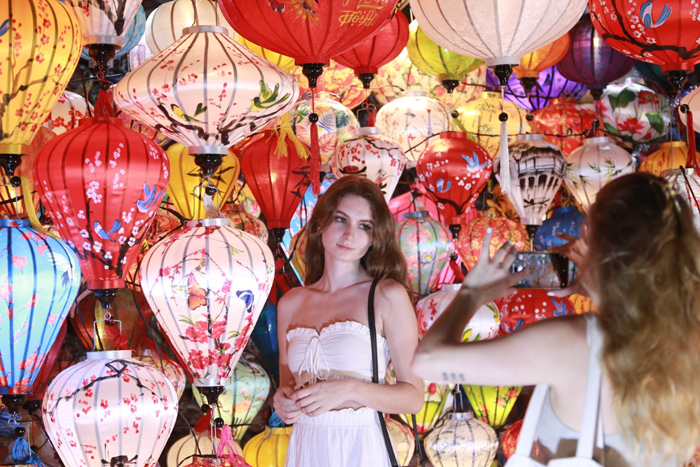
Not only in Hoi An, lanterns are products of traditional craft villages that are widely used in Vietnam. At restaurants, or even in many families, lanterns are very familiar decorations, especially on the traditional New Year or the Mid-Autumn Festival. Ha Linh Lantern Manufacturing Unit is one of the most famous addresses for lantern making combined with craft village experience tourism. Visitors can visit the lantern production process at the factory, buy or make their own lanterns with the craftsmen and bring them back as souvenirs for friends.
With their diverse colors and symbolic designs, Hoi An lanterns embody the essence of Vietnamese culture, representing both historical relics and contemporary beauty.
For lantern enthusiasts, the vibrant Lantern Festival in Hoi An is a must-see spectacle, must-do in Hoi An Vietnam. This festival is held on the 14th day of each lunar month and during the Mid-Autumn Festival. On these occasions, Hoi An will be covered with the colorful shimmer of lanterns. This will be an opportunity for visitors to capture magical moments with Hoi An.
11. Visit Hoi An handicraft workshop
- Address: 9 Nguyễn Thái Học, MinhAn ward, Hội An city, Quảng Nam province, Việt Nam
- Opening hours: 07:00 am - 06:00 pm
- Tel: +84 235 3910 216
- Google Map: https://goo.gl/maps/Xci6XDA8ty5o6iGH6

The Hoi An handicraft workshop is a special place in the heart of Hoi An's old town. It's a spot where people who love traditional Vietnamese crafts gather. Here, you can see how handmade things like embroidery, weaving, ceramics, and wooden furniture are made. It's also a meeting point for 12 traditional craft villages in Vietnam.
Beyond its mesmerizing display, the workshop's creations are also exported to foreign countries. This has great significance in spreading the quintessence of Vietnamese culture and art to friends around the world.
Hoi An handicraft workshop is not only a showcase of talent but also a celebration of culture and heritage. Each masterpiece embodies the soul of Vietnam's artistic brilliance. Hoi An Handicraft Workshop promises to bring you an unforgettable experience amidst the jewel of Vietnamese culture.
12. Attend a show at Hoi An memories land
- Address: 200 Nguyễn Tri Phương, Cẩm Châu ward, Hội An city, Quảng Nam province, Việt Nam
- Opening hours: 03:00 pm - 10:00 pm
- Ticket for Hoi An memories show: 150,000 VND - 1,200,000/ pax (7 USD - 51 USD)
- Tel: +84 904 636 600
- Web: http://hoianmemoriesland.com/
- Google Map: https://goo.gl/maps/Fe9BL4zRxDijB4aq6
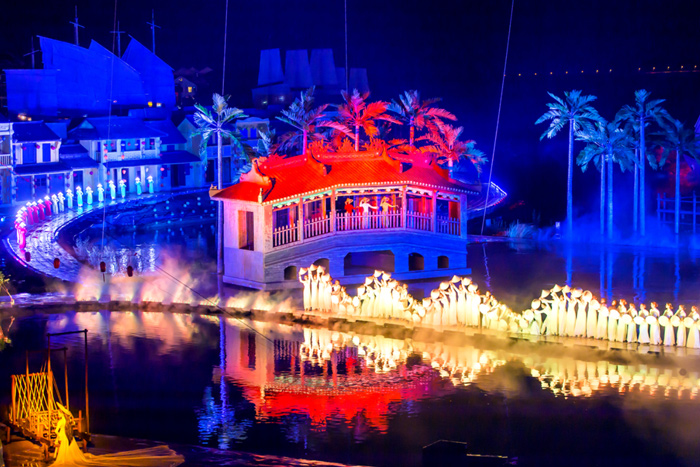
In November 2022, World Travel Awards - "Oscar of the world tourism industry" - honored Hoi An Memories Island as "the world's leading entertainment destination". This is like a recognition of efforts to bring Vietnamese culture, art and history to international friends. At Hoi An Memories Island, visitors will witness a real scene show gathering 500 professional dancers performing in the middle of Hoai River. This show depicts important events from different periods and introduces the diverse culture that formed Hoi An. With a combination of modern sound and lighting systems, professional performance props, the show "Hoi An Memories" will surely satisfy the audience.
Besides, Hoi An Memories Island is also an outstanding destination for green tourism - building and developing tourism based on the cultural and historical foundations of the land.
13. Relax at An Bang beach
- Address: Hai Bà Trưng, Hội An city, Quảng Nam province, Việt Nam
- Google Map: https://goo.gl/maps/uQAomj2XyrVrFj5c7

An Bang Beach, located just a few kilometers from Hoi An's ancient town, is a picturesque coastal paradise that attracts visitors with its pristine sandy shores and tranquil ambiance. This beach is the perfect destination for visitors, allowing visitors to unwind and soak up the sun while listening to the gentle lapping of the waves. In addition to swimming, visitors can experience surfing, paragliding or playing volleyball on the beach with friends.
An Bang beach has many cafes and restaurants to serve the entertainment and relaxation needs of visitors. You will enjoy fresh seafood and cool drinks after having fun and swimming. With its natural beauty and laid-back atmosphere, An Bang Beach is the perfect destination to unwind, recharge, and create lasting memories by the sea.
14. Discover My Son sanctuary
- Address: Duy Xuyên, Quảng Nam province, Việt Nam
- Opening hours: 06:30 am - 05:30 pm
- Entrance fee: 100,000 VND/ adult (4 USD) and 30,000 VND/ child (2 USD)
- Google Map: https://goo.gl/maps/mUk7EpA42n91oSKz7
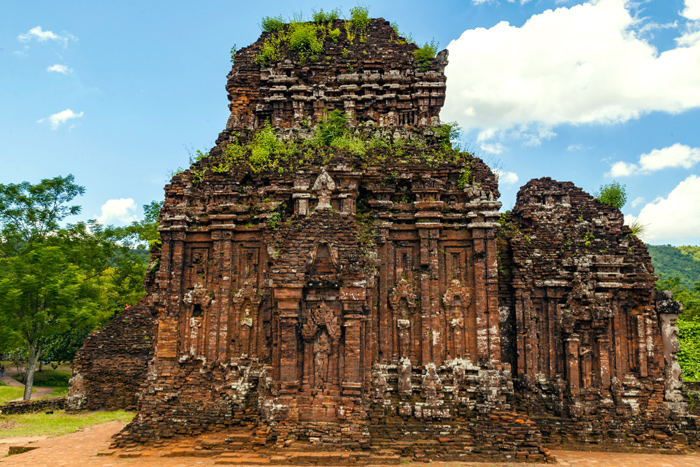
My Son Sanctuary, located in Quang Nam province, is a UNESCO World Heritage Site and a fascinating archaeological treasure in Vietnam. This ancient architectural complex dates back to the 4th century and served as the religious and political center of the Champa kingdom for many centuries. The architecture of My Son Sanctuary is heavily influenced by Hinduism: the entire tower is made of brick and stone. Nestled amidst lush greenery and surrounded by towering mountains, My Son Sanctuary exudes an aura of mystery and spirituality. The temples here are elaborately built, exquisitely carved with many unique and sophisticated details.
If you have the opportunity to come here, do not forget to experience the unique Kate festival of the Cham people. This is a traditional festival held in July every year according to the Cham calendar, an occasion to remember grandparents, ancestors and pray for the proliferation of all things. This will be a must-visit destination for history and heritage enthusiasts.
15. Take a day trip to Cham island (Cu Lao Cham)
- Address: Tân Hiệp, Quảng Nam province, Việt Nam
- Entrance fee: 90,000 VND (eco fee included)
- Canoe fares (2 ways): 400,000 VND/ adult (17 USD) and 100,000 VND - 200,000 VND/ child (4 USD - 9 USD)
- Wooden boat ticket (2 ways): 300,000 VND/ adult (13 USD) and 150,000 VND/ child (6 USD)
- Web: http://dulichculaocham.com.vn/
- Google Map: https://goo.gl/maps/XJ7wQMe76ZCJ9KSt5

Cham Island, also known as Cu Lao Cham, is a hidden gem off the coast of Hoi An in Vietnam. The island is part of the Cu Lao Cham Marine Park, a UNESCO Biosphere Reserve, making it an ideal destination for ecotourism enthusiasts - must-do in Hoi An Vietnam. Coming to this "green paradise", you will be able to fish with fishermen, watch the sea and watch corals, set up camp on the beach. The climate in Cu Lao Cham is cool and pleasant all year round, so it is home to many rare aquatic species.
Besides natural beauty, Cham Island also boasts a rich cultural heritage, with ancient temples and traditional fishing villages. An exciting underwater adventure awaits you, plan a trip to Cu Lao Cham to explore this beautiful land!
16. Shop at Hoi An central market
- Address: 19 Trần Phú street, Cẩm Châu ward, Quảng Nam province, Việt Nam
- Opening hours: 06:00 am - 10:00 pm
- Google Map: https://goo.gl/maps/8eWbRA1hbVzjRXj97
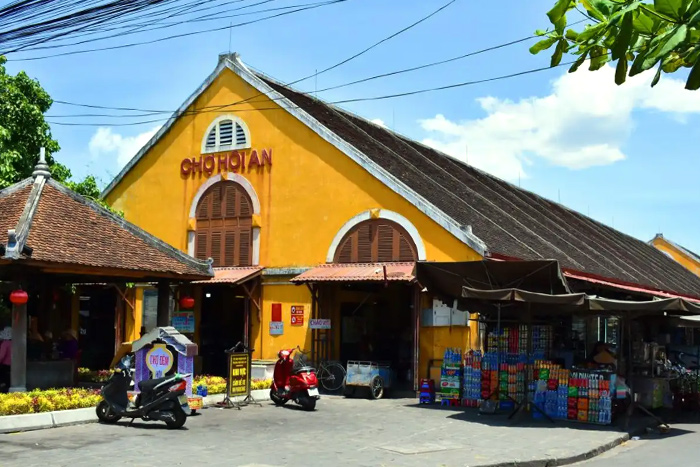
Are you wondering what to do in Hoi An? Hoi An Central Market is a vibrant and bustling marketplace located in the center of the ancient town of Hoi An Vietnam. Hoi An Market has rustic and idyllic features, similar to the old town. This is a paradise of flavors, colors and local culture. You can find anything here, from fresh fruits, vegetables, spices to souvenirs, clothes, and traditional crafts. Tourists
Come to the market early in the morning to fully feel the vibrant atmosphere of the market. will also enjoy delicious Hoi An cuisine and meet friendly locals. Hoi An Central Market is not just a shopping destination; it's a cultural experience that should not be missed during your visit to Hoi An.
17. Visit the Museum of Folklore in Hoi An
- Address: 33 Nguyễn Thái học street, Minh An ward, Quảng Nam province, Việt Nam
- Opening hours: 07:00 am - 09:30 pm
- Google Map: https://goo.gl/maps/5srGMybMMvzqHoqMA

The Museum of Folklore in Hoi An is a captivating attraction that offers a fascinating insight into the local culture and traditions of this ancient town. Hoi An Folklore Museum displays 483 artifacts, describing the customs, rituals and daily life of Hoi An residents throughout history. Visitors can explore traditional costumes, musical instruments, household items, and learn about the rich folklore and legends that have shaped the region's identity at the museum.
Coming to Hoi An Folklore Museum, you will see and understand more about the historical values formed over the years and how they have developed to this day. Add this place to your itinerary for a memorable trip.
In conclusion, Hoi An is an ideal location for those who are looking to discover the long history and culture of Vietnam. So pack your bags, embark on an unforgettable journey and let Hoi An weave the magic around you. Autour Asia, Vietnam Travel Agency hopes that you will complete this list of 17 best things to do in Hoi An and create impressive memories!
> Central Vietnam Tours
> 3-day itinerary Hoi An
> 5-day itinerary Da Nang Ba Na Hills Hoi An
> Da Nang Travel Guide
Hoi An is an ideal destination for both families and couples, offering a perfect balance of culture, relaxation, and charm. Families can enjoy leisurely bike rides through the countryside, lantern-making workshops, and peaceful boat trips on the Thu Bon River, while couples will love the romantic atmosphere of the Ancient Town, especially when the streets are illuminated by colorful lanterns at night. With its safe, walkable streets, friendly locals, and a wide range of activities from beach relaxation to cooking classes, Hoi An provides a memorable and enjoyable experience for all types of travelers.
What to eat in Hoi An? Hoi An is a food lover’s paradise, offering a rich blend of flavors that reflect its cultural diversity. Some must-try local dishes include Cao Lau, a signature noodle dish made with pork, fresh herbs, and crispy rice crackers; Mi Quang, turmeric-infused noodles served with shrimp, pork, and peanuts; and the delicate White Rose dumplings, a Hoi An specialty made from translucent rice dough. Don’t miss trying a Banh Mi Hoi An, often hailed as one of the best sandwiches in the world, and sampling Com Ga (chicken rice) - simple yet incredibly flavorful. Each dish tells a story of the town’s heritage and culinary creativity.
If you’re planning a trip to Hoi An, spending 2 to 3 days in Hoi An is ideal to truly experience the charm of this ancient town. In two days, you can stroll through the lantern-lit streets, visit historical landmarks like the Japanese Covered Bridge, and enjoy local dishes such as Cao Lau and Banh Mi Hoi An. With an extra day, you’ll have time to relax at An Bang Beach, take a boat ride along the Thu Bon River, or explore the nearby countryside and craft villages - making your stay in Hoi An both relaxing and memorable.
Related travel guide
Other similar articles
CUSTOMIZABLE BY LOCAL EXPERTS
Personalized trip at the original price!
REFUND GUARANTEE
We believe in our work and promise to give you money back.
GOOD PRICE / QUALITY
95% satisfied more than expected!
24/7 LOCAL SUPPORT
We are always available online to provide assistance at any time.
Most read articles
Autour Asia is highly recommended on
Embracing the mission of "Satisfied more than expected" and providing authentic experiences, we have received numerous recommendations on reputable travel forums:


















